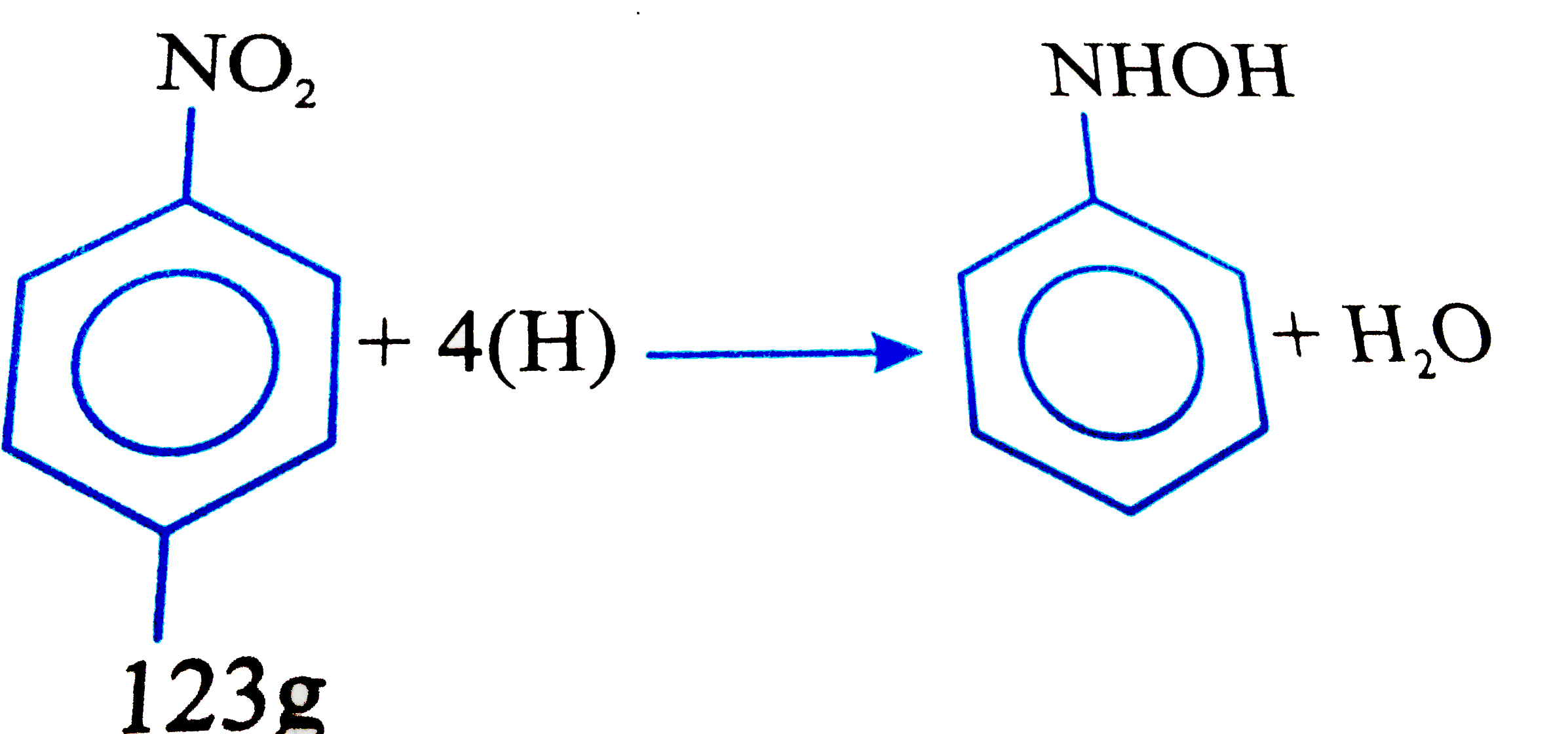1.23 g of Nitro Benzene on reduction with Zn+NH4Cl then its gives N-Phenyl hydroxyl amine that isomerised to 4-amino phenol. Then no. of electron involved and the element reduced is
24×1021,N
24×1024,N
12×1023,N
6×1023,N
The correct Answer is:A

123g of Nitro Benzene 4N electrons
Topper's Solved these Questions
Similar Questions
An organic compound [A] with molecular formula C5H8O2 is reduced to n-pentane on treatment with Zn−Hg/HCl. The compound [A] forms a dioxine with hydroxyl amine and give a positive iodoform test and Tollen's test. Identify the compound [A] and deduce its structure?
View SolutionOxidation and reduction process involves the transaction of electrons. Loss of electrons is oxidation and the gain of electrons is reduction. It is thus obvious that in a redox reaction, the oxidant is reduced by accepting the electrons and the reductant is oxidised by losing electrons. The reactions in which a species disproportionates into two oxidation states (lower and higher) are called disproportionation reactions. In electrochemical cells, redox reaction is involved, i.e., oxidation takes place at anode and reduction at cathode.
In the reaction:
I2+2S2O2−3→2I−+S4O2−6
View Solution
Knowledge Check
1.23 g of Nitro Benzene on reduction with Zn+NH4Cl then its gives N-Phenyl hydroxyl amine that isomerised to 4-amino phenol. Then no. of electron involved and the element reduced is
A24×1021NB24×1024NC12×1023ND6×1023NNitroalkanes are reduced by Zn+NH4Cl gives
A1∘ - aminesBN-alkyl hydroxyl amineCoximeDamideReduction of nitrobenzene in the presence of Zn/NH4Cl gives
AHydrazobenzeneBN-Phenyl hydroxylamineCAnilineDAzobenzene
The reaction of nitrocompounds to primary amines occurs through the intermediate formation of nitroso compound and hydroxylamine catalytic hydrogenation of reduction of nitro compound with an active metal and concentrated hydrochloric acid always gives the corresponding primary amines. In the neutral medium, the nitro compounds are reduced to corresponding hydroxylamines. However, in the basic medium, bimolecular reduction products are obtained which redult through initial condensation of nitroso and hydroxyl amine intermediates followed by reduction to give different products depending upon the nature of the reducing agent used
In the reduction of nitrobenzene, which of the following is the intermediate
View SolutionThe reaction of nitrocompounds to primary amines occurs through the intermediate formation of nitroso compound and hydroxylamine catalytic hydrogenation of reduction of nitro compound with an active metal and concentrated hydrochloric acid always gives the corresponding primary amines. In the neutral medium, the nitro compounds are reduced to corresponding hydroxylamines. However, in the basic medium, bimolecular reduction products are obtained which redult through initial condensation of nitroso and hydroxyl amine intermediates followed by reduction to give different products depending upon the nature of the reducing agent used
The reagent that reacts with nitromethane to form methyl hydroxylamine is ?
View SolutionWhat is the difference in oxidation state of nitrogen in between hydroxyl amine (NH2OH) and hydrazine (N2H4) ?
View SolutionStatement-1. The reaction of conc. HNO3 and conc. H2SO4 on nitrobenzene gives m- dinitrobenzene.
Statement-2. The nitro group in benzene ring decreases the electron density in the benzene ring.
View SolutionDiazonium salt formation and coupling reaction: When a reaction mixture of phenyl amine and nitrous acid is kept below 10∘C, a diazonium salt is formed. This reaction is called diazotization reaction.
_E01_891_Q01.png)
The diazonium ion, −N+2, is rather unstable and decomposes readily to nitrogen. However, delocalization of the diazonium from π−bond electron over a benzene ring phenyl diazonium sufficiently for it to form at low temperature. The phenyl diazonium ion behaves as an electrophile, and will attack another arene molecule such as phenol. Electrophilic subsitiution takes at the 4 position, producing 4-hydroxy phenyl azobenzene. The reaction is known as coupling reaction.
_E01_891_Q02.png)
The compound formed is an energetically stable, yellow azo dye (the azo group is −N=N−) The stability is due to extensive delocalisation of electrons via the nitrogen- nitrogen double bonds.
The azo dye obtained on reacting 4-aminophenol with nitrous acid (in dilute hydrochloric acid) below 10∘C and coupling the resulting diazonium salt with phenol is :
View Solution

